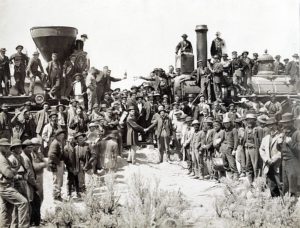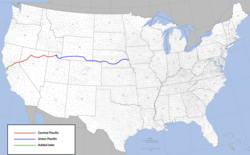
05/07/2022 | Celebrating National Train Day
May 7, 1300Z-2109Z, W4LX, Fort Myers, FL. Fort Myers Amateur Radio Club. CW 7.040 14.040; PSK31 14.070; SSB 7.260 14.260.
Certificate & QSL. SASE to: Fort Myers Amateur Radio Club, P.O. Box 61183, Fort Myers, FL 33906.
From the Railroad Museum of South Florida
May 2022 QST Page 82
In honor of National Train Day, we have been given permission to set up three ham radio stations (one in the museum and two outside) at the Railroad Museum of South Florida (Located in the Lakes Park – 7330 Gladiolus Drive in Fort Myers). Saturday, May 7, 2022 from 9am to 5pm
National Train Day is an annual event on the Saturday closest to May 10th to commemorate the driving in of the Golden Spike in Promontory, Utah at the Promontory summit which marked the completion of the first transcontinental railroad in the U.S.
The station inside the museum will be for CW. There will be two additional stations outside the museum buidling. One will be for SSB and the other PSK31/SSB.
If you are interested in participating in this event please drop us an email at train-day@fmarc.net,
In all likelihood we will have many interested folks so an operating schedule will likely be needed. Also, this is going to be in a very high visitor place so ham radio “educators” will also be needed to explain what we are doing.
We are hoping that this exciting opportunity will become an annual event for FMARC. I am sure there are many railroad hobbyists in the club as well that will find this activity to be quite fun.

| First transcontinental railroad | |||
|---|---|---|---|
| Overview | |||
| Other name(s) | Pacific Railroad | ||
| Owner | U.S. Government | ||
| Locale | United States of America | ||
| Termini | Council Bluffs, Iowa (Omaha, Nebraska) Alameda Terminal, starting September 6, 1869; Oakland Long Wharf, starting November 8, 1869 (San Francisco Bay) |
||
| Service | |||
| Operator(s) | Central Pacific Union Pacific |
||
| History | |||
| Opened | May 10, 1869 | ||
| Technical | |||
| Line length | 1,912 mi (3,077 km) | ||
| Track gauge | 4 ft 8+1⁄2 in (1,435 mm) standard gauge | ||
|
|||
North America’s first transcontinental railroad (known originally as the “Pacific Railroad” and later as the “Overland Route“) was a 1,911-mile (3,075 km) continuous railroad line constructed between 1863 and 1869 that connected the existing eastern U.S. rail network at Council Bluffs, Iowa with the Pacific coast at the Oakland Long Wharf on San Francisco Bay.[1] The rail line was built by three private companies over public lands provided by extensive US land grants.[2] Construction was financed by both state and US government subsidy bonds as well as by company issued mortgage bonds.[3][4][5][N 1] The Western Pacific Railroad Company built 132 mi (212 km) of track from the road’s western terminus at Alameda/Oakland to Sacramento, California. The Central Pacific Railroad Company of California (CPRR) constructed 690 mi (1,110 km) east from Sacramento to Promontory Summit, Utah Territory. The Union Pacific Railroad (UPRR) built 1,085 mi (1,746 km) from the road’s eastern terminus at the Missouri River settlements of Council Bluffs and Omaha, Nebraska westward to Promontory Summit.[7][8][9]
The railroad opened for through traffic between Sacramento and Omaha on May 10, 1869, when CPRR President Leland Stanford ceremonially tapped the gold “Last Spike” (later often referred to as the “Golden Spike“) with a silver hammer at Promontory Summit.[10][11] [N 2] In the following six months, the last leg from Sacramento to San Francisco Bay was completed. The resulting coast-to-coast railroad connection revolutionized the settlement and economy of the American West.[N 3][N 4] It brought the western states and territories into alignment with the northern Union states and made transporting passengers and goods coast-to-coast considerably quicker, safer and less expensive.
The first transcontinental rail passengers arrived at the Pacific Railroad’s original western terminus at the Alameda Terminal on September 6, 1869, where they transferred to the steamer Alameda for transport across the Bay to San Francisco. The road’s rail terminus was moved two months later to the Oakland Long Wharf, about a mile to the north, when its expansion was completed and opened for passengers on November 8, 1869.[15][16][N 5] Service between San Francisco and Oakland Pier continued to be provided by ferry.
The CPRR eventually purchased 53 miles (85 km) of UPRR-built grade from Promontory Summit (MP 828) to Ogden, Utah Territory (MP 881), which became the interchange point between trains of the two roads. The transcontinental line became popularly known as the Overland Route after the name of the principal passenger rail service to Chicago that operated over the length of the line until 1962.[19]
